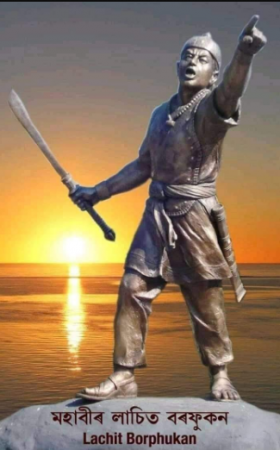
New Delhi: Lachit Borphukan, general of the Ahom Kingdom, successfully commanded his army to thwart the imperial expansion of the Mughal dynasty in the late 1600s. He is still remembered for his leadership and bravery in the face of overwhelming challenges.
Momai Tamuli Borbarua and Kunti Moran welcomed Lachit Borphukan into the world on November 24, 1622. His father was the chief of the Ahom army.
The Brahmaputra valley of eastern India was home to the Ahom kingdom. In 1228, it was initially established. Turkic and Afghan emperors of the Delhi Sultanate and later the Mughal Empire frequently attacked.
Also Read: Canada investigates claims that Chinese "police service stations" pose security threats
The Mughal-Ahom war began in 1615 and lasted for the rest of its duration. This was the environment in which Lachit was brought up. Lachit, after completing his education in the humanities and military strategy, was given the duty of serving as Soldhara Barua (scarf bearer), equivalent to the private secretary of the Ahom king.
Before being named the Commander of the Ahom Army, he previously held other important posts such as Superintendent of the Royal Horse Stable and Superintendent of the Royal Household Guards.
Lachit Borphukan was appointed commander-in-chief until the Mughals captured Guwahati and forced the Ahoms to sign the humiliating Treaty of Ghilajhrighat, which imposed severe restrictions on the Ahom kingdom. Lachit Borphukan would follow Raja Chakradhwaj Singha's instruction to free the entire region from Mughal occupation.
Battle of Saraighat
By the summer of 1667, Lachit had raised an army and completed the necessary preparations. Guwahati was successfully recaptured by his army from the Mughal army.
After learning of the defeat at Guwahati, Emperor Aurangzeb (born November 3, 1618) sent an expeditionary force from Dacca under Ram Singh.
Since the Ahom forces were few in number and technologically backward, Lachit used guerilla tactics to successfully drive them out.
Ram Singh used deception as he was fully aware that the Ahom army would be easily defeated if their commander was removed. Ram Singh's letter was attached to an arrow which went into the Ahom camp. Later it was made Chakradhwaj Singha.
Also Read: Iran planning to attack Qatar during FIFA World Cup- Report
According to the letter, Lachit had received one lakh rupees in return for leaving Guwahati. The king was angered that his general was allegedly engaging in negotiations with the enemy and began to question his integrity, but his prime minister Atan Buragohain persuaded him that it was a good idea for the Mughals to send Chakradhwaj Singh to dismiss the general. The result was It was a ploy to strengthen the Mughals, who had been defeated so far.
Ram Singh traveled to Guwahati with a naval flotilla in 1671, crossing the Brahmaputra river after trying every possible route. In the vicinity of Saraighat, he came across an Ahom flotilla commanded by Lachit Borphukan.
The Ahom soldiers were once again outnumbered and moved to a wide open area and began to lose the will to fight. When Lachit saw that some elements had started running away, he himself started gathering in a boat.
Although he was very ill, Lachit threw some of his soldiers into the sea when he offered to carry them to safety, shouting that he would "die doing his duty to his king and country, Even if it means they have to do it." himself." Lachit's soldiers were inspired and came together to fight valiantly on the Brahmaputra.
Lachit Borphukan emerged victorious. The Mughals had to flee from Guwahati. The western border of the Ahom kingdom, the Manas River, saw the Mughals in pursuit. Borphukan ordered his troops not to pursue the retreating army.
Lachit Borphukan died in 1672. His remains are buried at Lachit Maidan, which was built by King Udayaditya Singh in the same year, 16 km from Jorhat.
The Mughals then continued to invade Ahom territory, taking Guwahati in 1679, and in 1682 the Ahoms finally ended the Ahom–Mughal conflict.
The legacy of Lachit Borphukan
The Lachit Borphukan Gold Medal is awarded to the top cadet of the National Defense Academy. It was first instituted in 1999 as a result of a statement made by General VP Malik, who claimed that the medal would encourage military personnel to emulate the bravery and sacrifice of Barphukan.
Also Read: Australia clears the Free Trade Agreement with India
Every year on 24 November, Assam celebrates Lachit Diwas to honor the bravery of Lachit Borphukan and the victory of the Assamese army in the Battle of Saraighat.